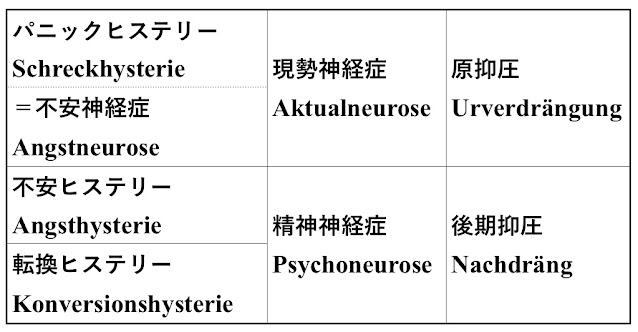|
ヒステリーの第一段階は、驚愕ヒステリーと呼ぶことができる。その主な症状は、心的裂目の下での驚愕の表現である。
Man kann dieses erste Stadium der Hysterie als Schreckhysterie bezeichnen; ihr Primärsymptom ist die Schreckäusserung bei psychischer Lücke. (フロイト、フリース宛書簡 Freud, Manuskript K: DIE ABWEHRNEUROSEN, Beilage zum Brief vom 1. 1. 1896)
|
|
この初期フロイトの驚愕ヒステリー[Schreckhysterie]概念は、「パニックヒステリー」とも訳されうる語であり、現勢神経症の代表的な症状「不安神経症」に相当する。
|
|
不安神経症は、興奮の源泉、障害の原因が身体的領域にあり、ヒステリーや強迫神経症が心的領域にあるのとは異る。
die Angstneurose …daß die Erregungsquelle, der Anlaß zur Störung, auf somatischem Gebiete liegt, anstatt wie bei Hysterie und Zwangsneurose auf psychischem. 〔・・・〕
不安神経症は、抑圧された表象に由来しておらず、心理学的分析においてはそれ以上には削減不能であり、精神療法では対抗不能である。Angstneurose …stammt er nicht von einer verdrängten Vorstellung her, sondern erweist sich bei psychologischer Analyse als nicht weiter reduzierbar, wie er auch durch Psychotherapie nicht anfechtbar ist. (フロイト『ある特定の症状複合を「不安神経症」として神経衰弱から分離することの妥当性について』1894年、摘要)
|
|
フロイトにはヒステリーに関して別に不安ヒステリー、転換ヒステリー用語がある。
|
|
現勢神経症の三つの純粋な形式は、神経衰弱、不安神経症、心気症である。daß wir drei reine Formen der Aktualneurosen unterscheiden: die Neurasthenie, die Angstneurose und die Hypochondrie. 〔・・・〕
現勢神経症の症状は、しばしば、精神神経症の症状の核であり、先駆けである。この種の関係は、神経衰弱 と「転換ヒステリー」として知られる転移神経症 、不安神経症と不安ヒステリーとのあいだで最も明瞭に観察される。しかしまた、心気症とパラフレニア(早期性痴呆とパラノイア) の名の下の障害形式のあいだにもある。das Symptom der Aktualneurose ist nämlich häufig der Kern und die Vorstufe des psychoneurotischen Symptoms. Man beobachtet ein solches Verhältnis am deutlichsten zwischen der Neurasthenie und der »Konversionshysterie« genannten Übertragungsneurose, zwischen der Angstneurose und der Angsthysterie, aber auch zwischen der Hypochondrie und den später als Paraphrenie (Dementia praecox und Paranoia) zu erwähnenden Formen. (フロイト『精神分析入門』第24章、1917年)
|
|
現勢神経症は原抑圧、つまり欲動の固着の病理とすることができる。
|
|
おそらく最初期の抑圧(原抑圧)が、現勢神経症の病理を為す[die wahrscheinlich frühesten Verdrängungen, …in der Ätiologie der Aktualneurosen verwirklicht ist]〔・・・〕精神神経症は、現勢神経症を基盤としてとくに容易に発達する[daß sich auf dem Boden dieser Aktualneurosen besonders leicht Psychoneurosen entwickeln](フロイト『制止、症状、不安』第8章、1926年)
|
|
抑圧の第一段階ーー原抑圧された欲動ーーは、あらゆる「抑圧」の先駆けでありその条件をなしている固着である[Die erste Phase besteht in der Fixierung, (primär verdrängten Triebe) dem Vorläufer und der Bedingung einer jeden »Verdrängung«. ]。〔・・・〕
この欲動の固着 は、以後に継起する病いの基盤を構成する[Fixierungen der Triebe die Disposition für die spätere Erkrankung liege](フロイト『症例シュレーバー 』1911年、摘要)
|
|
この原抑圧の審級にある現勢神経症に対して、精神神経症は後期抑圧の審級にある。
|
|
われわれが治療の仕事で扱う多くの抑圧は、後期抑圧の場合である。それは早期に起こった原抑圧を前提とするものであり、これが新しい状況にたいして引力をあたえる[die meisten Verdrängungen, mit denen wir bei der therapeutischen Arbeit zu tun bekommen, Fälle von Nachdrängen sind. Sie setzen früher erfolgte Urverdrängungen voraus, die auf die neuere Situation ihren anziehenden Einfluß ausüben. ](フロイト『制止、症状、不安』第2章、1926年)
|
|
ここではヒステリー概念だけを取り上げれば、次のように区分できる。
そして不安神経症としてのパニックヒステリーが、現代臨床のパニック障害に相当する。
|
現勢神経症のカテゴリーにおいて、フロイトが最も強調するのは、不安神経症である。The category of actual neurosis Freud stresses most is anxiety neurosis(ポール・バーハウ PAUL VERHAEGHE, ACTUAL NEUROSIS AS THE UNDERLYING PSYCHIC STRUCTURE OF PANIC DISORDER, SOMATIZATION, AND SOMATOFORM DISORDER, 2007年)
|
|
実際のところ、DSM-IVのパニック障害の記述は、フロイトの不安神経症の記述とほとんど同じである。
the DSM–IV description of panic disorder is almost exactly the same as Freud's description of anxiety neurosis.(ポール・バーハウ他 Paul Verhaeghe and Stijn Vanheule, ACTUAL NEUROSIS AND PTSD, 2005年)
|
|
以下、主にポール・バーハウの注釈である。
|
|
現勢病理、特に不安神経症/パニック障害の原因は、主体の内的欲動興奮が大他者によって応答されない、あるいは不十分であるという事実にある。
the causal factor of actualpathology, and of anxiety neurosis/panic disorder in particular, lies in the fact that the subject's internal drive excitation is not―or is insufficiently―answered by the Other. (ポール・バーハウ Paul Verhaeghe, On Being Normal and Other Disorders, 2004)
|
|
ーー《我々はここでラカニアンの「大他者」概念を使っている。ラカンにとって大他者は具体的な他者(特に母と父)であると同時に言語である。
Here we are using the Lacanian concept of the “Other.” For Lacan, the Other is both the concrete other (particularly the mother and father) and language》.(Paul Verhaeghe and Stijn Vanheule, ACTUAL NEUROSIS AND PTSD, 2005)
|
|
我々は今、これらの発見をフロイトの病因論、より具体的には、ヒステリーを主な例とする「防衛の神経精神病」の起源に関する彼の理論に結びつけることができる。「驚愕ヒステリー」、すなわち「パニックヒステリー」は、第一段階、出発点、すなわち、心的装置がその処理課題に失敗するたびに起こるパニック発作にとってのフロイトの名である。同じ文の中で、フロイトは、ヒステリー発作の間、ある表象が抑圧されていると考えるべきではないと付け加えている:「その主な症状は、心的裂目による驚愕の表出である」。このことは、ヒステリーでは何かが抑圧されるというよりも、むしろ何かが置き残され、以前の言語以前のレベルに固着されたままであることを示唆している。
|
|
We can now link these findings to Freud's views on etiology, more specifically to his theory of the origin of the “neuropsychoses of defense,” taking hysteria as the main example. “Schreck hysteria,” or “panic hysteria” is his name for the first phase, the departure point, that is, a panic attack that occurs whenever the psychological apparatus fails in its processing task:…. In the same text, Freud adds that we should not assume that a certain representation is repressed during hysterical attacks: “its primary symptom is the manifestation of fright accompanied by a gap in the psyche.” This implies that in hysteria it is not so much that something is repressed, but rather that something has been left behind and remains fixated at an earlier prelinguistic level. (ポール・バーハウ Paul Verhaeghe, On Being Normal and Other Disorders, 2004)
|
|
|
|
フロイトはヒステリーの固有な欲動の固着として、ヒステリーにおける口唇要素を繰り返し強調した(フロイト 1978 [1905e])。フロイトにとって、これは気質的要因と関係があった。Freud repeatedly stressed hysteria's oral component as its characteristic drive fixation (Freud 1978 [1905e]). For Freud, this had to do with constitutional factors〔・・・〕
いずれの精神神経症に見られるように、それに先立つ現勢病理の場がある。フロイトは後者を「驚愕ヒステリー」、つまりパニック発作と表現した。それは心的裂目との遭遇におけるパニック発作である。このパニック発作と不安神経症との結びつきはきわめて明白である。ヒステリーはここから始まるが、シニフィアン化に進み、その古典的作用は恐怖症や転換ヒステリーである。このようにして、原初の欲動要素はファルス化される。
As in every psychoneurosis, there is a preceding actualpathological position. Freud described the latter as “Schreckhysteria,” that is, a panic attack in confrontation with a “psychic lack” . Its connection with the anxiety neurosis is quite clear. Hysteria starts out from this but proceeds onto a processing of the signifiers, whose classical effects are phobic and/or conversion hysteria. In this way, the original drive component becomes phallicized: (ポール・バーハウ Paul Verhaeghe, On Being Normal and Other Disorders, 2004)
|
|
ファルス化とは、言語化を意味する。
|
|
ファルスの意味作用とは実際は重複語である。言語には、ファルス以外の意味作用はない。Die Bedeutung des Phallus est en réalité un pléonasme : il n'y a pas dans le langage d'autre Bedeutung que le phallus. (ラカン, S18, 09 Juin 1971)
|
|
ファルスの意味作用[Die Bedeutung des Phallus]はフロイトの《象徴的意味作用[die symbolische Bedeutung]》(『制止、症状、不安』第1章、1926年)と等価であり言語化である、ーー《象徴界は言語である[Le Symbolique, c'est le langage]》(Lacan, S25, 10 Janvier 1978)
最後に不安神経症(パニック障害)と他の症状の転換順である。
|
|
出発点は不安神経症やパニック障害、身体化であり、不安ヒステリーや境界例がそれに続く。次の段階は恐怖症と転換ヒステリーで、最終点は強迫神経症である。
The starting point is anxiety neurosis or panic disorder and somatization followed by anxiety hysteria and borderline. The next step leads to phobic and conversion hysteria, and the final point is obsessional neurosis. (ポール・バーハウ Paul Verhaeghe, On Being Normal and Other Disorders, 2004)
|
|
なおフロイトは《強迫神経症言語は、ヒステリー言語の方言である。die Sprache der Zwangsneurose ist gleichsam nur ein Dialekt der hysterischen Sprache》( 『強迫神経症の一例についての見解〔鼠男〕』 1909年)としている。
|
|
